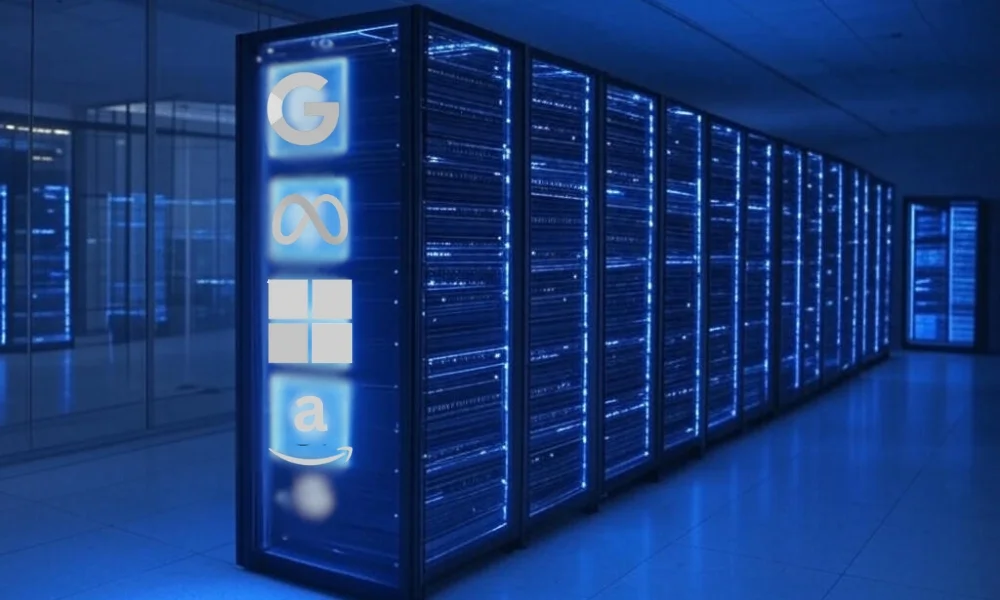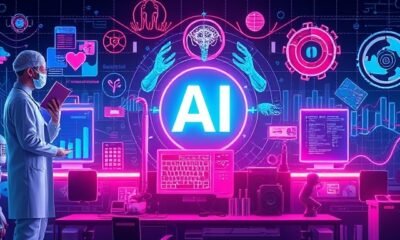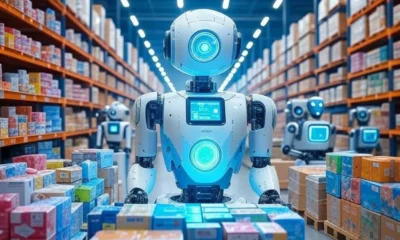Artificial Intelligence
Big Tech’s $325 Billion Bet: How U.S. Giants Are Powering the Future of AI Infrastructure in 2025
In 2025, U.S. tech giants Amazon, Microsoft, Google, and Meta are pouring $325 billion into AI infrastructure, constructing massive data centers to drive the next wave of artificial intelligence innovation. This unprecedented investment not only solidifies America’s edge in the global AI landscape but also promises to reshape industries and everyday life in the years ahead.

Imagine a number so large it could fund entire nations: $325 billion. Now picture that sum poured into the beating heart of artificial Intelligence , massive data centers humming with power, churning through exaflops of calculations to train the next generation of AI models. In 2025, this isn’t a sci-fi fantasy, it’s the reality being built by U.S. tech titans Amazon, Microsoft, Google, and Meta. Together, these companies are set to invest a collective $325 billion this year alone to construct and expand the infrastructure that will fuel AI’s explosive growth. This isn’t just a business move; it’s a declaration of intent, a signal that the United States aims to remain the undisputed leader in the global AI landscape.
AI Infrastructure 2025
AI infrastructure refers to the advanced computing systems, hyperscale data centers, and cutting-edge semiconductor technology that power artificial intelligence. This backbone supports AI innovation, enabling applications in healthcare, finance, and automation. In 2025, Big Tech’s investment underscores the critical role of AI infrastructure in the global economy.
AI revolution is no longer a distant promise – it’s here, reshaping industries, economies, and daily life. But behind every chatbot, self-driving car, or medical breakthrough lies an unsung hero: infrastructure. Without vast data centers, cutting-edge chips, and oceans of energy, AI would stall. In 2025, Big Tech’s unprecedented spending underscores a critical truth: the race for AI supremacy hinges on who can build the biggest, fastest, and smartest systems. This article dives into the scale of this investment, why it matters, who’s driving it, and what it means for America’s place in the world and your future.
A $325 Billion Power Play:
Let’s start with the number: $325 billion. It’s a figure so colossal it demands context. For perspective, it’s more than the GDP of countries like Denmark or Colombia. It dwarfs the U.S. federal budget for education and rivals annual spending on national defense. In 2025, Amazon, Microsoft, Google, and Meta are pooling this fortune into a singular mission: constructing the data centers that will power AI’s next leap forward.
Breaking it down, each company brings its own heft to the table. Microsoft and Amazon, giants of cloud computing through Azure and AWS, might each contribute upwards of $100 billion, building on their 2024 investments that already topped $50 billion apiece. Google, with its sprawling AI research and consumer empire, could match that scale, while Meta, focused on AI-driven platforms like Instagram and the metaverse, might chip in $50-75 billion. These are projections, of course—exact figures remain fluid—but the trend is clear: 2025 marks an escalation from prior years, where total Big Tech infrastructure spending hovered around $200 billion annually.
What’s this money buying? Data centers – sprawling complexes packed with servers, GPUs, and cooling systems, designed to handle the astronomical computational demands of AI. These aren’t your average server farms; they’re hyperscale facilities, some spanning millions of square feet, capable of training models with trillions of parameters or running real-time AI for billions of users. Think of them as the factories of the digital age, producing not goods but intelligence.
Backbone of the AI Revolution
Why does this matter? Because AI infrastructure isn’t just a support system—it’s the backbone of the entire revolution. Modern AI, from ChatGPT to autonomous drones, relies on staggering amounts of computing power. Training a single large language model can require exaflops—quintillions of calculations per second—powered by thousands of specialized chips like NVIDIA’s H100 GPUs or Google’s custom TPUs. Once trained, these models need equally robust systems to deliver instant responses, whether it’s recommending a video or diagnosing a disease.
This infrastructure isn’t optional; it’s existential. Without it, AI innovation slows to a crawl. A decade ago, a data center might have powered a website or a database. Today, it’s the engine behind breakthroughs that could solve climate change, cure cancer, or reshape geopolitics. As one industry expert put it, “Data centers are the new oil rigs of the 21st century—except they drill for insights, not crude.”
For the U.S., this is more than a tech story—it’s a national priority. Just as highways and power grids defined 20th-century progress, AI infrastructure is the foundation of 21st-century dominance. The $325 billion investment isn’t just about keeping pace; it’s about setting the standard, ensuring that American companies—and by extension, American values—lead the charge.
Who’s Building What?
So, who’s behind this monumental effort? Let’s meet the players and peek into their blueprints.
Amazon:
Amazon Web Services (AWS) is the world’s largest cloud provider, and in 2025, it’s doubling down on AI. The company is rolling out new data centers optimized for machine learning workloads, from training generative AI to hosting enterprise solutions. These facilities, likely spread across the U.S. and key global hubs, will leverage Amazon’s logistics prowess to minimize latency and maximize efficiency. AWS’s goal? To be the go-to platform for businesses adopting AI, from startups to Fortune 500s.
Microsoft:
Microsoft’s Azure platform is a juggernaut in its own right, and its deep ties to OpenAI (think ChatGPT) give it a unique edge. In 2025, Microsoft is building hyperscale data centers to support both its cloud customers and its own AI ambitions. These centers will power everything from Copilot enhancements to enterprise tools, with a focus on seamless integration. Expect heavy investment in the U.S. Midwest and South, where land and energy are plentiful.
Google:
Google’s approach is a blend of research and reach. Its AI division, including DeepMind, demands cutting-edge infrastructure, while its consumer products—Search, YouTube, Maps—rely on real-time AI for billions of users. In 2025, Google is expanding its network of energy-efficient data centers, powered by custom TPUs and renewable energy. The company’s mantra: build smart, not just big. Look for new facilities in states like Oregon and Nevada, where Google already has a footprint.
Meta:
Meta’s focus is narrower but no less ambitious. AI drives its social platforms—think content moderation, ad targeting, and the metaverse—so its 2025 data centers are tailored for real-time processing. These facilities will handle massive datasets, like video feeds or VR simulations, with an emphasis on speed and scale. Meta’s investments might lean toward coastal hubs like California and New York, aligning with its user base.
While their strategies differ—cloud-first for Amazon and Microsoft, product-driven for Google and Meta—these companies share a common thread: competition. They’re racing not just against each other but against time, as AI’s demands grow exponentially.
U.S. Leadership in the Global AI Landscape:
Zoom out, and this $325 billion investment takes on a grander significance: it’s a cornerstone of U.S. leadership in the global AI race. America already hosts the world’s most advanced AI firms, from OpenAI to Anthropic, and its research hubs – Silicon Valley, Boston, Seattle – are unrivaled. But leadership isn’t guaranteed. China, with its state-backed $150 billion AI plan through 2030, and the EU, with its regulatory muscle, are formidable contenders.
The U.S. advantage lies in its private sector. While China’s government pours funds into centralized projects, American innovation thrives on Big Tech’s agility and capital. This $325 billion injection isn’t just about data centers – it’s about staying ahead in an AI arms race where the stakes are economic, military, and cultural. A robust infrastructure ensures U.S. companies can outpace rivals in developing smarter, faster, and more ethical AI.
But challenges loom. Semiconductor shortages, exacerbated by global supply chain woes, could delay construction. Energy demands are another hurdle – data centers guzzle power, and 2025’s AI boom could strain grids or clash with sustainability goals. The U.S. must navigate these obstacles to turn ambition into reality. If it succeeds, this investment could cement its status as the AI epicenter for decades.
Beyond 2025: What This Means for Society
The ripple effects of this $325 billion bet will extend far beyond tech boardrooms. Economically, it’s a boon – thousands of jobs in construction, engineering, and tech will spring up, while industries like chip manufacturing and renewable energy get a boost. Small towns near new data centers might see population spikes, echoing the oil boomtowns of old.
Societally, the impact is profound. With this infrastructure, AI applications will accelerate—think AI doctors diagnosing patients, smarter cities managing traffic, or classrooms tailored to every student. But risks lurk: centralizing so much power in a few companies could widen inequality or raise ethical questions about surveillance and bias. The U.S. will need to balance innovation with oversight.
Looking to 2026 and beyond, this spending could spark an AI “golden age,” where breakthroughs become routine. Yet it might also squeeze out smaller players, as Big Tech’s scale becomes insurmountable. The future hinges on execution—will these data centers deliver on their promise, or will they be monuments to overreach? For now, 2025 is a tipping point, and the world is watching.
Conclusion:
In 2025, Amazon, Microsoft, Google, and Meta aren’t just spending $325 billion—they’re building the future. Their data centers will power AI’s next wave, from mundane efficiencies to world-changing discoveries. More than that, they’re reinforcing U.S. leadership in a global AI landscape where every byte counts. This isn’t just about technology; it’s about who shapes the 21st century.
As these facilities rise, they’ll touch your life—whether through a smarter phone, a safer car, or a healthier planet. In 2025, Big Tech isn’t just building data centers—they’re laying the groundwork for a world where AI defines progress. The question is: are we ready for what comes next?
-

 Artificial Intelligence8 months ago
Artificial Intelligence8 months agoWhat is Artificial Intelligence? A Comprehensive Guide for Businesses and Enthusiasts
-

 Artificial Intelligence6 months ago
Artificial Intelligence6 months agoHow to Use Grok AI: A Complete Guide
-

 Artificial Intelligence8 months ago
Artificial Intelligence8 months agoUnlocking the Power of Artificial Intelligence Tools
-

 Artificial Intelligence7 months ago
Artificial Intelligence7 months agoWhat is DeepSeek? Revolutionizing AI with Cutting-Edge Solutions
-

 Artificial Intelligence3 months ago
Artificial Intelligence3 months agoAI Technologies in Warehouse Automation:
-

 Artificial Intelligence4 months ago
Artificial Intelligence4 months agoMeta’s AI Push: The Standalone Assistant App Set to Rival ChatGPT
-

 Artificial Intelligence3 months ago
Artificial Intelligence3 months agoHow Artificial Intelligence is Revolutionizing Logistics:
-

 Artificial Intelligence3 months ago
Artificial Intelligence3 months agoPredictive Analytics for Demand Forecasting:


